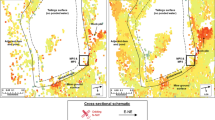Abstract
At present, near-surface shear wave velocities are mainly calculated through Rayleigh wave dispersion-curve inversions in engineering surface investigations, but the required calculations pose a highly nonlinear global optimization problem. In order to alleviate the risk of falling into a local optimal solution, this paper introduces a new global optimization method, the shuffle frog-leaping algorithm (SFLA), into the Rayleigh wave dispersion-curve inversion process. SFLA is a swarm-intelligence-based algorithm that simulates a group of frogs searching for food. It uses a few parameters, achieves rapid convergence, and is capability of effective global searching. In order to test the reliability and calculation performance of SFLA, noise-free and noisy synthetic datasets were inverted. We conducted a comparative analysis with other established algorithms using the noise-free dataset, and then tested the ability of SFLA to cope with data noise. Finally, we inverted a real-world example to examine the applicability of SFLA. Results from both synthetic and field data demonstrated the effectiveness of SFLA in the interpretation of Rayleigh wave dispersion curves. We found that SFLA is superior to the established methods in terms of both reliability and computational efficiency, so it offers great potential to improve our ability to solve geophysical inversion problems.
Similar content being viewed by others
References
Beaty, K. S., Schmitt, D. R., and Sacchi, M., 2002. Simulated annealing inversion of multimode Rayleigh wave dispersion curves for geological structure: Geophys. J. Int., 151, 622–631.
Buchen, P. W., and Ben-Hador, R., 1996, Free-mode surfacewave computations: Geophysical Journal International, 124(3), 869–887.
Dal Moro, G., Pipan, M., and Gabrielli, P., 2007, Rayleigh wave dispersion curve inversion viagenetic algorithms and marginal posterior probability density estimation: Journal of Applied Geophysics, 61(1), 39–55.
Elbeltagi, E., Hegazy, T., and Grierson, D., 2005. Comparison among five evolutionary-based optimization algorithms: Advanced Engineering Informatics, 19(1), 43–53.
Eusuff, M. M., and Lansey, K. E., 2003, Optimization of water distribution network design using the shuffled frogleaping algorithm: Journal of Water Resources Planning and Management, 129(3), 210–225.
Eusuff, M., Lansey, K., and Pasha, F., 2006, Shuffled frogleaping algorithm: a memetic meta-heuristic for discrete optimization: Engineering Optimization, 38(2), 129–154.
Liu, Z., and Wang, F., 2016, Improvement of discrete shuffled frog-leaping algorithm and application in compressed sensing reconstruction: Journal of Jilin University Engineering and Technology Edition, 46(4), 1261–1268.
Lu, Y., Peng, S., Du, W., et al., 2016, Rayleigh wave inversion using heat-bath simulated annealing algorithm: Journal of Applied Geophysics, 134, 267–280.
Luo, X., Yang, Y., and Li, X., 2008. Solving TSP with shuffled frog-leaping algorithm: Eighth international conference on intelligent systems design and applications, IEEE, 3, 228–232.
Poormirzaee, R., 2016, S-wave velocity profiling from refraction microtremor Rayleigh wave dispersion curves via pso inversion algorithm: Arabian Journal of Geosciences, 9(16), 673.
Socco, L. V., Foti, S., and Boiero, D., 2010, Surface-wave analysis for building near-surface velocity models-Established approaches and new perspectives: Geophysics, 75(5), A83–A102.
Song, X., Gu, H., Zhang, X., et al., 2008, Pattern search algorithms for nonlinear inversion of high-frequency Rayleigh wave dispersion curves: Computers & Geosciences, 34(6), 611–624.
Song, X., Tang, L., Lv, X., et al., 2012, Application of particle swarm optimization to interpret Rayleigh wave dispersion curves: Journal of Applied Geophysics, 84, 1–13.
Song, Y. Y., Castagna, J. P., Black, R. A., et al., 1989, Sensitivity of near-surface shear-wave velocity determination from Rayleigh and Love waves: Expanded Abstracts of the 59th Annual International Meeting, SEG, Expanded Abstracts, 509–512.
Tran, K. T., and Hiltunen, D. R., 2012a, One-dimensional inversion of full waveforms using a genetic algorithm: Journal of Environmental & Engineering Geophysics, 17(4), 197–213.
Tran, K. T., and Hiltunen, D. R., 2012b, Two-dimensional inversion of full waveforms using simulated annealing: Journal of Geotechnical & Geoenvironmental Engineering, 138(9), 1075–1090.
Xia, J., Miller, R. D., and Park, C. B., 1999, Estimation of near-surface shear-wave velocity by inversion of Rayleigh waves: Geophysics, 64(3), 691–700.
Xiao, Y., Lin, T., Li, B., Hou, B., and Shi, G., 2016, Improvement strategy of adaptive parameter adjustment for shuffled frog leaping algorithm: Systems Engineering and Electronics (in Chinese), 38(8), 1939–1950.
Xu, Y., Wang, L., Zhou, G., et al., 2011, An effective shuffled frog leaping algorithm for solving hybrid flow-shop scheduling problem: The International Journal of Advanced Manufacturing Technology, 52(5-8), 699–713.
Yamanaka, H., and Ishida, H., 1996, Application of genetic algorithm to an inversion of surface wave dispersion data: Bulletin of the Seismological Society of America, 86, 436–444.
Yan, S. G., Xie, F. L., Li, C. Z., et al., 2016, Dispersion function of Rayleigh waves in porous layered half-space system: Applied Geophysics, 13(2), 333–342.
Zhou, T. F., Peng, G. X., Hu, T. Y., Duan, W. S., Yao, F. C., and Liu, Y. M., 2014, Rayleigh wave nonlinear inversion based on the fire fly algorithm: Applied Geophysics, 11(2), 167–178.
Acknowledgments
We would like to show our gratitude to Paul Michaels for providing the field data, and we thank Khiem Tran for allowing us to use his crosshole result and for his encouragement with the inversion results. We would like to thank the editors and reviewers for their constructive comments and suggestions on this manuscript.
Author information
Authors and Affiliations
Corresponding author
Additional information
This research is supported by the National Natural Science Foundation of China (No. 41374123).
Sun Cheng-Yu received his MS (1997) and PhD (2001) degree in applied geophysics from China University of Petroleum (East China). Now he is a professor of this university and is devoted to teaching and research works on the theory of seismic wave propagation and the method of seismic prospecting.
Rights and permissions
About this article
Cite this article
Sun, CY., Wang, YY., Wu, DS. et al. Nonlinear Rayleigh wave inversion based on the shuffled frog-leaping algorithm. Appl. Geophys. 14, 551–558 (2017). https://doi.org/10.1007/s11770-017-0641-x
Received:
Revised:
Published:
Issue Date:
DOI: https://doi.org/10.1007/s11770-017-0641-x




